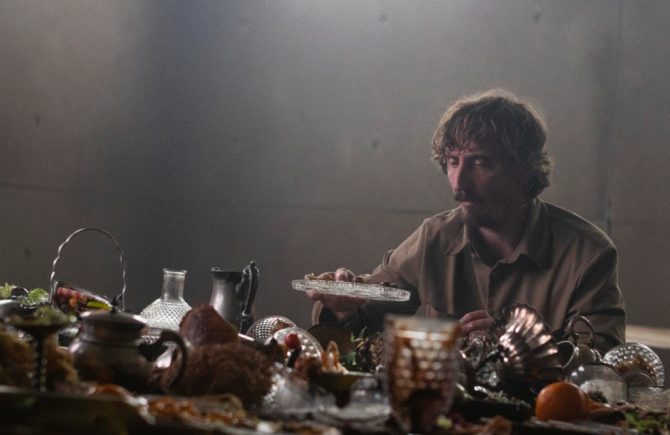56 pages in. Who would’ve thought?
This weekend, I watched “The Platform.”
It’s a movie on Netflix with a clever premise. You agree to be a part of a 6-month experiment and, if you finish, they give you something important you need in life.
The catch is you don’t know what the experiment is until you’re in it.
So our hero, Goreng, wakes up in a concrete room with a roommate and a giant square hole in both the middle of the ceiling and the middle of the floor. We also notice a big number on the wall – 43. Before Goreng knows what’s going on, a giant table of food descends into the room and stops.
The giant table of food, however, is leftovers. Chicken bones and mostly eaten cake. Goreng watches in confusion as his roommate, the older conniving Trimagasi, ravenously attacks the leftovers.
What Goreng will soon learn is that the table of food comes down once a day, starting on the top floor with all the food. The table lowers every 60 seconds and each floor can eat as much food as they want during that time.
Goreng stares at the picked-over leftovers, the result of 42 previous floors of eating, and then asks the question all of us are wondering. “How many floors are there?” “200,” Trimagasi says. 200? If there’s only this much food on floor 43, how much reaches floor 100, floor 150, or floor 200? The thought is too scary to think about.
The story is obviously a metaphor for capitalism and it works well. Also, it’s a dream concept for a producer, which is why I got so jealous the second I saw it. A never-before-used high concept that takes place in a single location? It doesn’t get any better than that. You could shoot this movie for a quarter of a million dollars if you had to.
The movie seems to be getting a divisive reaction. The people who love it really love it. But when I tried to get my brother to watch it, he couldn’t make it past the ten minute mark. “It’s a guy in a room. Who cares?” He said. “I’m already bored.”
Because I have the 2-Week Screenplay Challenge on my mind, I imagined what it was like writing this movie and how it might be applicable to what all of you are dealing with.
My theory is that this was a first draft. It was a really good first draft – it probably had half-a-dozen polishes, otherwise known as “light rewrites” (change a scene here, alter a scene there). But you could feel the writer searching for interesting story elements as the story moved into its second half.
What really gave it away was the ending, which was the kind of ending writers write when they don’t have an ending. They convince themselves they’re being thoughtful and “challenging” the audience, when in reality they throw in some vague nonsensical finale and hope the audience does the work for them.
What I’ve found with endings is that you never nail them on the first draft. They alway take numerous drafts to figure out because endings are payoffs to setups. This requires you to go back to the beginning, set some things up, then pay them off in the climax. Which means starting a new draft so you can do that.
Then you learn your new setups aren’t perfect so you start to fine-tune them. And that takes more drafts.
And here’s what I’ve ultimately found. You can’t write a great second half until you know exactly how your movie ends. Because everything needs to be setting up that final sequence. If you’re not 100% clear on what that final sequence is, your second half is always going to be squishy.
All of this is to remind you that it’s okay to be messy right now. It’s okay, as you make your way to the climax, if none of the puzzle pieces are fitting together the way you want them to. That will come. I promise you, if you choose to keep writing this script after this draft, it will come.
The only thing you need to worry about right now is having fun. Don’t take this process so seriously or you’re going to hate yourself and want to give up.
And if The Platform truly was a first draft? It shows you what’s possible with a strong concept. You don’t need to be perfect. You just need to exploit as many cool things about your concept as possible. Get into your audiences’ heads. What do you think they would want from your concept? Give them that. I was curious about what the table looked like on the 200 level. They put our characters on the 200 floor later so we see that. That’s how to exploit your concept.
So keep writing. I want one of you to have a featured movie on Netflix. It’s not going to happen unless YOU. KEEP. WRITING.


